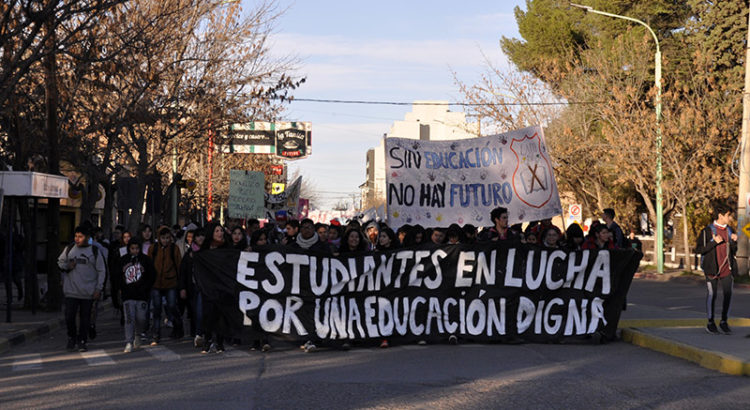por: Izquierda Diario/ 12-06-2019
La masiva movilización de los colegios secundarios de Cipolletti reclamando las mejoras en la escuela pública, busca garantías en el acceso a una educación de calidad, tanto en lo edilicio como en lo pedagógico.
La marcha que se realizó en Cipolletti este lunes 10/06 ha sido sin dudas una bocanada de aire que nos regala la juventud en defensa de la educación pública. Es que la movilización que fue llamada por la comunidad educativa de la ESRN 152 del Barrio Anahi Mapu, y a la que se plegaron las ESRN 120, 5, 89, 147, 35, 15, 17 y el CET 22 dejó demostrado que la reforma educativa dista mucho de ser la mejora en la educación que tanto promovieron desde el Gobierno.
La situación de los diferentes establecimientos educativos varía en complejidad, algunos de ellos reclaman mejoras edilicias importantes como calefacción, vidrios, mobiliario, pizarrones, en otros. En el caso de la ESRN 152 la situación demuestra la improvisación con la que se implementó la reforma educativa, ya que en su caso particular demandan que el Gobierno provea todos los elementos necesarios para el dictado de la orientación en artes visuales. Modalidad que le asignó la reforma educativa implementada en la provincia de Río Negro.

Desde el Gobierno, ante la multitud de estudiantes que se concentraron en las puertas de la Supervisión accedieron a recibir a una comitiva que representaba a cada colegio para recabar la información de los reclamos. En una reunión que se desarrolló durante un par de horas y que fue acompañada por una bulliciosa manifestación de estudiantes que cantaron exigiendo respuestas al Gobierno y combatiendo la fría mañana del lunes.
Desde los representantes de Educación solo se comprometieron a enviar veedores para certificar los pedidos de los estudiantes en cada establecimiento. Los estudiantes en una improvisada asamblea informativa comunicaron que ellos no van a firmar nada y que van a llevar a sus colegios lo que se comprometió el Gobierno, pero remarcaron que los funcionarios ya saben de antemano cuales son los reclamos de cada colegio porque es aquello que ellos no garantizan.

En la reunión las comunidades educativas les entregaron las demandas de cada establecimiento y demandaron el presupuesto necesario para el funcionamiento de una educación de calidad. Ante la requisitoria de los funcionarios de Educación una madre de la comunidad de la ESRN 152 le increpó que la plata para garantizarles sus pedidos estaba en el dinero que le destinan todos los meses a la educación privada. Que si le interesaba la lleve adonde corresponde, a la educación pública.

Un Gobierno que se ve apremiado en querer mostrarse preocupado por la educación se ve jaqueado por la movilización estudiantil que desnuda las falencias de la reforma, donde entre otras cosas no se contempló el presupuesto necesario para su implementación, donde la juventud empieza a hacer su experiencia con la propuesta educativa del Gobierno y denuncian que se les garantice el derecho a una educación pública de calidad.
Párrafo aparte merece el nefasto rol de la burocracia sindical de Unter Central quienes se reunieron a espaldas de los estudiantes e intentando dinamitar la unidad que comenzaba a gestarse entre los colegios unificando sus reclamos. En dichas reuniones sellaron acuerdos que fueron rechazados por los estudiantes y principalmente por la comunidad educativa de la ESRN 152 epicentro donde nació el conflicto.

Sin dudas la jornada de hoy marcó un punto importante en la lucha que vienen desarrollando los estudiantes en Cipolletti que se mantiene en alerta para garantizar sus demandas. Es que ahora el Gobierno tomó nota de la fuerza de la juventud movilizada, que tiñó la mañana de la tranquila ciudad valletana. “Es hermoso ver a los chicos peleando por la educación” deslizó una vecina al paso de la movilización, donde la rebeldía combatió al conformismo y ganó las calles.
Fuente de la información: https://laizquierdadiario.com/Marcha-de-estudiantes-en-Cipolletti-desnuda-las-falencias-de-la-Escuela-Secundaria-rionegrina
























 Users Today : 116
Users Today : 116 Total Users : 35423230
Total Users : 35423230 Views Today : 129
Views Today : 129 Total views : 3358402
Total views : 3358402